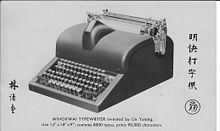- Chinese typewriter
-
The Chinese typewriter is an electromechanical typewriter invented and patented by Dr. Lin Yutang. The patent, No. 2613795, was filed on April 17, 1946 by Lin, and was issued by the United States Patent and Trademark Office on October 14, 1952. One of Lin's intentions was to help modernize China. The typewriter was called "MingKwai"; Lin promoted it as "The Only Chinese Typewriter Designed for Everybody's Use". ("Ming kwai" (Chinese: 明快; pinyin: míngkuài; Wade–Giles: ming-k'uai) means "clear and quick".)
Contents
History
Lin had a prototype machine custom built by the Carl E. Krum Company, a small engineering-design consulting firm with an office in New York City. That multilingual typewriter was the size of a conventional office typewriter of the 1940s. It measured 36 × 46 × 23 cm (14" x 18" x 9"). The typefaces fit on a drum. A "magic eye" was mounted in the center of the keyboard which magnifies and allows the typist to review a selected character.[1] Character selection is accomplish by first pressing 2 keys to choose a desired character which is arranged according to a system Lin devised for his dictionary of the Chinese language. The selected Chinese character appeared in the magic eye for preview,[1] the typist then pressed a "master" key, similar to today's computer function key. The typewriter could create 90,000 distinct characters using either one or two of six character-containing rollers, which in combination has 7000 full characters and 1,400 character radicals or partial characters.[1]
The inspired aspect of the typewriter was the system Lin devised for a Chinese alphabet. It had thirty geometric shapes or strokes (somewhat analogous to the elements of a glyph). These became "letters" by which to alphabetize Chinese characters. He broke tradition with the long-standing system of radicals and stroke order writing and categorizing of Chinese characters, inventing a new way of seeing and categorizing.
The typewriter was not produced commercially. According Lin's daughter, Lin Tai-Yi, the day she was to demonstrate the machine to executives of the Remington Typewriter Company, they could not make it work. Although they did get the machine fixed for a press conference the next day, it was to no avail. Lin found himself deeply in debt. In 1947, Lin paid income taxes owed to the Internal Revenue Service and went to work in Paris for UNESCO.
Patents
- US2,613,795: Chinese Typewriter, Lin Yutang
See also
- Japanese typewriter
Notes
- ^ a b c Sorrel, Charlie (2009), How it Works: The Chinese Typewriter, wired.com, http://www.wired.com/gadgetlab/2009/02/how-it-works-ch/
References
- Bliven, Bruce Jr. The Wonderful Writing Machine. New York: Random House, 1954.
- Chinese Typewriter: A Real Character Study", Business Week (August 30, 1947), p.16.
- Lin, Tai-Yi. "My Father, Lin Yutang", Reader's Digest (December 1990) p:161-191.
- Lin, Yutang, Lin Yutang's Chinese-English Dictionary of Modern Usage. Hong Kong: The Chinese University of Hong Kong, 1972.
External links
Categories:- Technology stubs
- Typewriters
Wikimedia Foundation. 2010.


